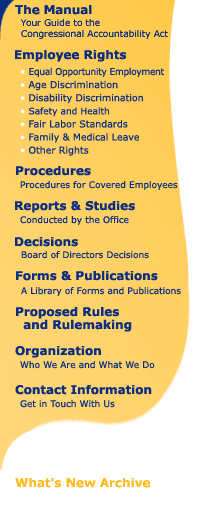 |

|
 |
|||
|
Questions and Answers about Section 508 In 1998, Congress amended the Rehabilitation Act of 1973 (29 U.S.C. 794d). Section 508 of these amendments requires that all Federal agencies make their electronic information accessible to people with disabilities. Below are some of the most frequently asked questions about Section 508 and what it means for Congress and the Legislative Branch. Q. What is “Section 508"? What does it require? A. Section 508 is one part of the changes made to the Rehabilitation Act when it was amended in 1998. Section 508 requires that the full range of electronic and information technologies give employees and members of the public who are disabled access to information in a way that is comparable to access available to others. Section 508 was enacted to eliminate barriers in information technology and make available new opportunities for people with disabilities. Q. I thought the Americans with Disabilities Act (ADA) already required that electronic information be accessible to people with disabilities. How does Section 508 differ from the requirements of the ADA? A. The ADA does already require that the Federal government make electronic information available to the disabled. Section 508, however, goes a step further than the ADA. The ADA only mandates that electronic information be made available in an alternative format (such as in paper form). Section 508 requires that individuals with disabilities be able to access information in a way that is comparable to access available to others. Q. What kind of electronic information does Section 508 apply to? A. Section 508 applies to the full range of electronic and information technologies, including software, computing, presentation, and storage mediums. Q. Does Section 508 apply to web sites? Are dramatic changes needed to make a web site compliant with Section 508? A. Section 508 does apply to the internet and web sites. Most changes required by Section 508 are relatively simple to implement and do not detract from the overall web site design or its experience by unimpaired viewers, but have a dramatic impact on accessibility and ease of use for the disabled. Q. How can web sites be made accessible to the sight impaired when almost everything is visual? Does Section 508 prohibit the use of graphics and photos on web sites? A. No, compliance with Section 508 does not prohibit images or certain types of format styles on web sites. Instead, it only requires that these elements be accessible in an alternative manner. For example, to accommodate the blind or visually impaired, labels and descriptors should be applied to the code for pictures and graphs so that they can be “read” by electronic screen readers and turned into audible information or data for refreshable Braille displays. While these labels cannot provide an actual image to the visually impaired, they help describe the element so that its context can be conveyed. Q. Does Congress have to comply with Section 508 standards? A. Section 508 currently only applies to Executive Branch departments and agencies of the Federal government. Compliance with Section 508 is currently only voluntary for the Legislative Branch and the private sector. Q. Does this mean that no Congressional web sites are fully accessible to the disabled according to Section 508 standards? A. No, great strides have been made in implementing Section 508 standards in the Legislative Branch even though compliance is only voluntary. Many web sites are now accessible and in compliance with Section 508, and other sites are being modified to conform with the standards. There are, however, still Legislative Branch web sites that lack the basic features needed to adequately accommodate users who are disabled. Q. Does the Office of Compliance encourage voluntary compliance with Section 508? A. Yes, although Section 508 does not currently apply to Congress, the Office of Compliance encourages all Legislative Branch entities to follow its standards, especially in regard to web sites. Maintaining a web site that is Section 508 compliant will ensure that all constituents and members of the public have easy access to legislative information posted online. Q. How can I find out more about Section 508 and its standards? A. Standards for the implementation of Section 508 have been created by the Access Board, an independent Federal agency devoted to accessibility for people with disabilities. The Access Board’s web site, www.access-board.gov, has extensive information about Section 508 and its standards.
|
|
||